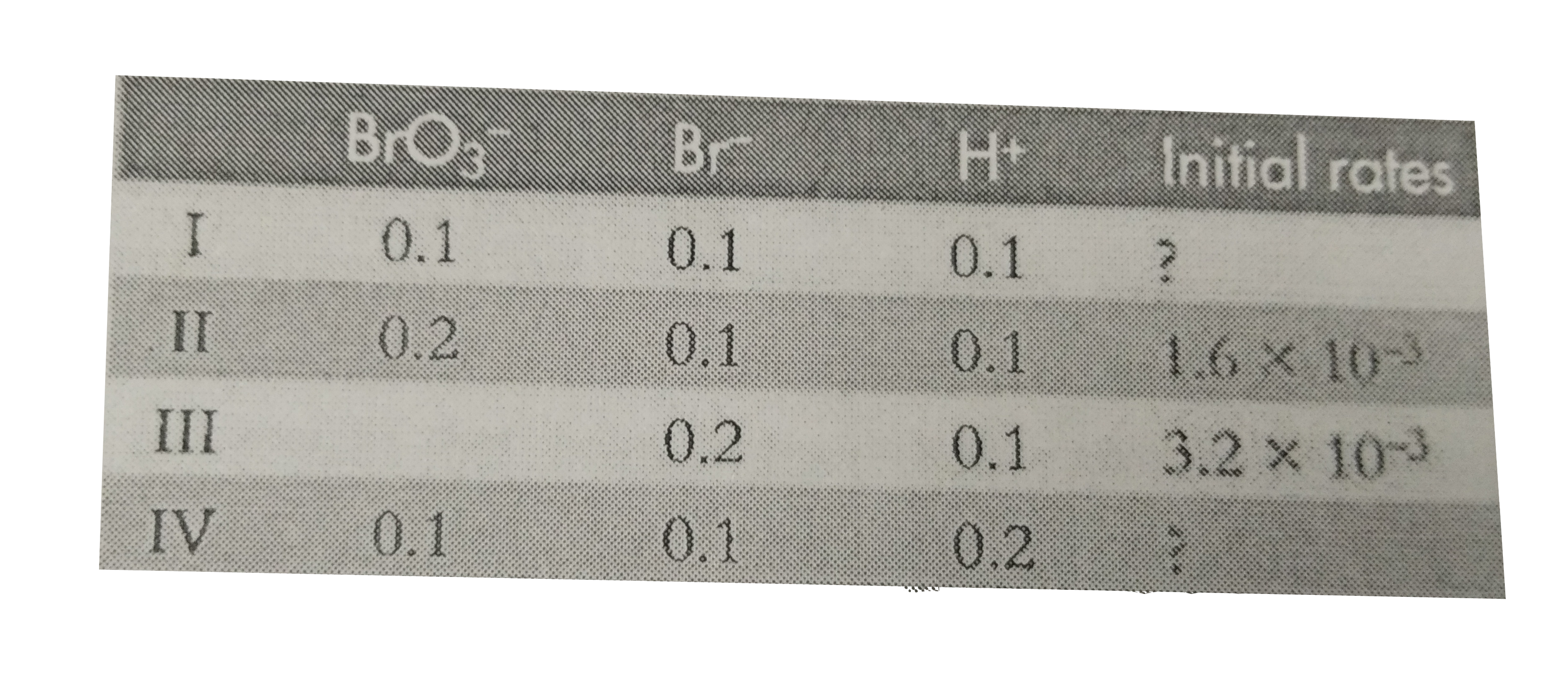BrO−3+5Br−+6H+→3Br2+3H2O
The order of reaction with respect to BrO−3 is 2 and with respect to other reactants is one. Complete the following table.

(i) relation between rate law and order of a reaction
(ii) calculation of initial rate of reaction in experiment I on the change of concentration of BrO−3 in experiment II and the order of reaction with respect to BrO−3
(iii) calculate of concentration of BrO−3 in experiment III based on the change of initial rate in experiment III, change of concentration of other reactants and the order of reaction with respect to Br−andH+
(iv) calculate of initial rate in experiment IV on the basis of change of concentration of all the reaction
Topper's Solved these Questions
- CHEMICAL KINETICS AND EQUILIBRIUMBOOK - PEARSON IIT JEE FOUNDATIONCHAPTER - CHEMICAL KINETICS AND EQUILIBRIUMEXERCISE - Level 3
10 Videos
- CHEMICAL KINETICS AND EQUILIBRIUMBOOK - PEARSON IIT JEE FOUNDATIONCHAPTER - CHEMICAL KINETICS AND EQUILIBRIUMEXERCISE - Level 1
43 Videos
- ATOMIC STRUCTURE BOOK - PEARSON IIT JEE FOUNDATIONCHAPTER - ATOMIC STRUCTURE EXERCISE - LEVEL-3
8 Videos
- CHEMICAL BONDING BOOK - PEARSON IIT JEE FOUNDATIONCHAPTER - CHEMICAL BONDING EXERCISE - Level 3
10 Videos
Similar Questions
Determining the order of reaction from the rate law: Bromide ion is oxidized by bromate ion in acidic solution. 5Br−(aq.)+BrO−3(aq.)+6H+(aq.)→Br2(aq.)+3H2O(l)
The expermentally determined rate law is
Rate=k[Br−][BrO−3][H+]2
What is the order of reaction with respect to each of the reactants and what is teh overall reaction order ?
Strategy : To find the reaction order with respect to each reactant, look at the exponents in the rate law, not the coefficients in the balanced chemical equation, and then sum the exponents to obtain the overall reaction order.
View SolutionOxidation state of Br in Br2andBrO−3 is
View Solution
Knowledge Check
In the reaction,
BrO−3(aq)+5Br−(aq)+6H+→3Br2(l)+3H2O
The rate of appearance of bromine (Bry) is related to rate of disappearance of bromide ions asAd[Br2]dt=-5/3(d[Br^(-)])/(dt)Bd[Br2]dt=5/3(d[Br^(-)])/(dt)Cd[Br2]dt=3/5(d[Br^(-)])/(dt)Dd[Br2]dt=-3/5(d[Br^(-)])/(dt)For the reaction H++BrO−3+3Br−→5Br2+H2O which of the following relation correctly represents the consumption & formation of reactants and products:
Ad[Br−]dt=−35d[Br2]dtBd[Br−]dt=−35d[Br2]dtCd[Br−]dt=−53d[Br2]dtDd[Br−]dt=53d[Br2]dtBrOɵ3+5Brɵ→Br2+3H2O
IF 50mL0.1MBrOɵ3 is mixed with 30mL of 0.5MBrɵ solution that contains excess of H⊕ ions, the moles of Br2 formed areA6.0×104B1.2×10−4C9.0×10−3D1.8×10−3
For the chemical reaction:
5Brɵ+BrOɵ3+6H⊕→3Br2+3H2O
Rate =k[Brɵ][BrOɵ3][H⊕]
What is the molecularity and order of reaction with respect to [Brɵ] ?
View SolutionFor the chemical reaction:
5Brɵ+BrOɵ3+6H⊕→3Br2+3H2O
Rate =k[Brɵ][BrOɵ3][H⊕]
What is the molecularity and order of reaction with respect to [Brɵ] ?
View SolutionFor the chemical reaction,
5Br−+BrO−3+6H−→3Br2+3H2O
the rate expression is rate =k[Br−][BrO−3][H+]2, calculate:
(a) order of reaction
(b) apparent molecularity of reaction
View SolutionFor the reaction H++BrO−3+3Br−→5Br2+H2O which of the following relation correctly represents the consumption & formation of reactants and products:
View SolutionBrOɵ3+5Brɵ→Br2+3H2O
IF 50mL0.1MBrOɵ3 is mixed with 30mL of 0.5MBrɵ solution that contains excess of H⊕ ions, the moles of Br2 formed are
View Solution
